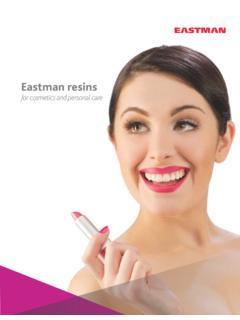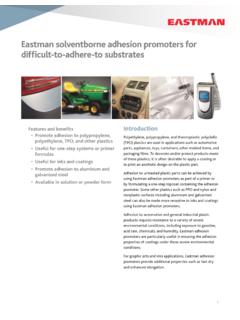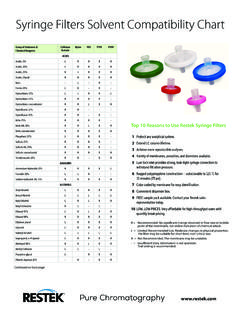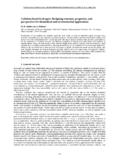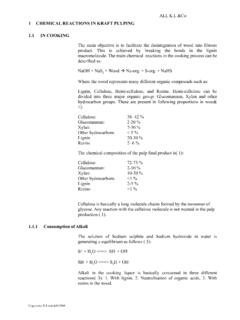Transcription of E-325H EASTMAN Cellulose-Based Specialty Polymers
1 EASTMAN Cellulose-Based Specialty polymers22 ContentsPerformance benefits in coatings 4 EASTMAN cellulose esters: CA, CAP, & CAB 4 Types 5 cellulose acetate butyrate (CAB) 5 cellulose acetate propionate 5 cellulose acetate 6 Selection 10 CA esters 10 CAP esters 10 CAB esters 10 cellulose esters as coatings additives and modifiers 14 Markets, technologies, and substrates 17 Automotive coatings 17 Coatings for metal 18 Coatings for plastic 18 Coatings for wood 19 Coil coatings 21 cellulose esters in graphic arts 23 Coatings for cloth 25 Coatings for paper 25 Coatings for leather 26 Thermally reflowable lacquers 26 Melt coatings 27 Vacuum-metallizing and bronzing lacquers 27 Preparation of pigment chips 27 Radiation curable coatings 27 Formulating techniques 28 CAB esters 28 Adding EASTMAN CABs as solutions 30 Other resins as cosolvents 30 Viscosity blending 30 Food Contact Status 313 This publication provides the protective coating, printing ink.
2 And related industries with a general discussion of the commercially available organic acid esters of cellulose : cellulose acetate (CA), cellulose acetate propionate (CAP), and cellulose acetate butyrate (CAB). It includes basic information on physical properties, solubility properties in various solvents and monomers, and intercompatibility properties of various cellulose esters. Typical uses for cellulose esters are discussed briefly as a general guide to selecting esters for various are the least soluble and compatible of EASTMAN s portfolio of cellulose esters. They require stronger solvents but, as a result, offer excellent chemical resistance. They have high glass transition temperatures and produce tough and hard films. CAPs have improved compatibility and solubility and are used in applications where low odor is esters are used as binders in protective and decorative coatings for metal, wood, textiles, cloth, paper, plastic, and leather.
3 EASTMAN CABs are used as binders by formulators because they provide excellent color and color retention, toughness, flexibility, flow control, and good weather esters are also useful as coatings additives where they can provide a significant performance edge. Frequently described as versatile problem solvers, cellulose esters provide qualities such as good flow and leveling, faster drying, sag resistance, viscosity control, intercoat adhesion, and metal flake esters are compatible with many resins and are also soluble in low-cost solvent systems. Most CABs are soluble in esters, ketones, glycol ethers, glycol ether esters, blends of alcohols and aromatic hydrocarbons, and they are quite tolerant of diluents such as aromatic hydrocarbons and alcohols. Films produced from EASTMAN CAB are optically clear, very tough, and hard and possess a high degree of ultraviolet data in this publication is intended as a source of basic information.
4 Additional data on the properties and performance of specific esters and formulation and application details are available on and are covered in separate literature on these products and technical assistance with their selection and use are also available through your EASTMAN representative. EASTMAN also manufactures Cellulose-Based Polymers used in controlled drug delivery. These Polymers are produced under strict manufacturing conditions required by the Food and Drug Administration for pharmaceutical excipients. More information can be obtained by contacting the Excipients Business Group or Technical Service through your EASTMAN Cellulose-Based Specialty polymers44 EASTMAN Cellulose-Based Specialty Polymers (continued)Performance benefits in coatingsWhen used as an additive, modifying resin, or major film former in printing inks and coatings applications, cellulose esters provide a number of performance benefits including.
5 Reduced dry time Improved flow and leveling Reduced cratering Sag control Color control in multipigment systems Improved sprayability Reduced picture framing Viscosity control Redissolve resistance Resistance to yellowing Stable carrier for metallic pigments Metallic flake control Efficient pigment dispersion medium Reduced blocking Solvent craze resistance Polishability UV stability Reduced plasticizer migration Gloss controlEastman cellulose esters: CA, CAP, & CABE astman manufactures CA, CAP, and CAB. All three products are available with a range of substituents and molecular weights that determine their solubility, compatibility, viscosity, and hardness. Viscosities are determined using the falling-ball method, according to ASTM D1343 in the solution described as Formula A, ASTM D817.
6 Viscosities in poise are converted to ASTM seconds equivalent to values obtained under ASTM D817. In EASTMAN nomenclature for cellulose esters, the viscosity of each individual ester is indicated in its product code. For example, EASTMAN CAB-381-2 has a viscosity of 2 seconds, EASTMAN CAB-381-20 has a viscosity of 20 seconds, and EASTMAN CAB-531-1 has a viscosity of 1 Cellulose-Based Specialty Polymers (continued)TypesCellulose acetate butyrate (CAB)There is a wide range of butyryl, acetyl, and hydroxyl levels available in EASTMAN CABs and, consequently, a wide range of properties. An ester with a medium butyryl level, such as EASTMAN CAB-381, is widely soluble and compatible with resins and plasticizers. It serves in many coatings applications including wood finishes; automotive topcoats; rubber and plastic coatings; cloth coatings; glass coatings; flexographic, gravure, and screen-printing inks; hot melts; and adhesives.
7 It is also used as a medium in which to disperse pigments on a differential-speed two-roll mill. CABs are stable to ultraviolet light and do not react with dyes, fluorescent colors, or metallic pigments. Because this product is useful in so many different types of coatings, it is commonly referred to as the general-purpose CAB-551, an ester with the highest practical butyryl level, is used in cross-linked finishes to improve dry-to-touch time, reduce cratering, provide a better pigment-dispersion medium, improve intercoat adhesion, and improve coating performance. Because it is soluble in many monomers, including styrene, EASTMAN CAB-551 is a valuable ingredient in ultraviolet-cured coatings and inks. Certain EASTMAN CABs are manufactured at high hydroxyl levels to provide alcohol solubility.
8 Solutions of these cellulose esters in alcohol are used where conventional solvents such as aromatics, esters, or ketones are not feasible. With their high hydroxyl content, these butyrates are useful in curing finishes, such as baking enamels and acid-catalyzed of a CAB must be made with care because there is a wide latitude of solubility, compatibility, and performance. Butyrate esters of low molecular weight (low viscosity) are designed to be used as additives or as reactive intermediates in curing finishes. The CAB molecule may be considered a polyol, especially when the hydroxyl content is high. Cross-linking the butyrates with amino resins or isocyanates enhances solvent resistance and performance of the acetate propionateCAP properties are intermediate between CA and CAB.
9 They resemble CA in many performance properties and are similar to CAB in solubility and compatibility. Like acetates, the propionates have low odor and thus can be used where this is a requirement. These properties make propionates especially useful in inks, overprint varnishes (OPVs), plastic coatings, paper coatings, and various reprographic processes. The solubility of high-hydroxyl propionate in alcohol-water mixtures makes it useful in flexographic inks and OPVs to provide low odor, nonyellowing characteristics, fast solvent release, and good adhesion to plastic films and esters can be used effectively to disperse pigments. Propionates are also stable to ultraviolet light and do not react with dyes, fluorescent colors, or metallic Cellulose-Based Specialty Polymers (continued) cellulose acetateLacquer-type CAs possess certain characteristics that make them difficult to formulate as coatings.
10 However, these characteristics are valuable in certain areas of the protective-coating are soluble only in strong solvents such as acetone, methyl ethyl ketone, and ethyl acetate, and they have very low tolerance for hydrocarbons. These esters only have limited compatibility with commercially available resins. Only very active plasticizers such as dimethyl phthalate or triacetin will remain in the film without exudation. The hardness and melting point of CAs are relatively characteristics would seem to limit uses, but they yield desirable properties for a number of applications. These include solvent- and grease-resistant coatings for paper products, wire, and cloth; dopes and cements for model airplanes; lacquers for electrical insulation and for the manufacture of capacitors; barrier and release coatings for pressure-sensitive tapes; and protective coatings for plastic items such as shoe heels and pen acetate butyrateR1, R2, R3 = Acetyl, Butyryl, or HCA weathers well and is nonyellowing on long-term exposure to the sun, making it useful as a coating for signs and decals.





